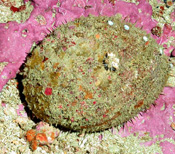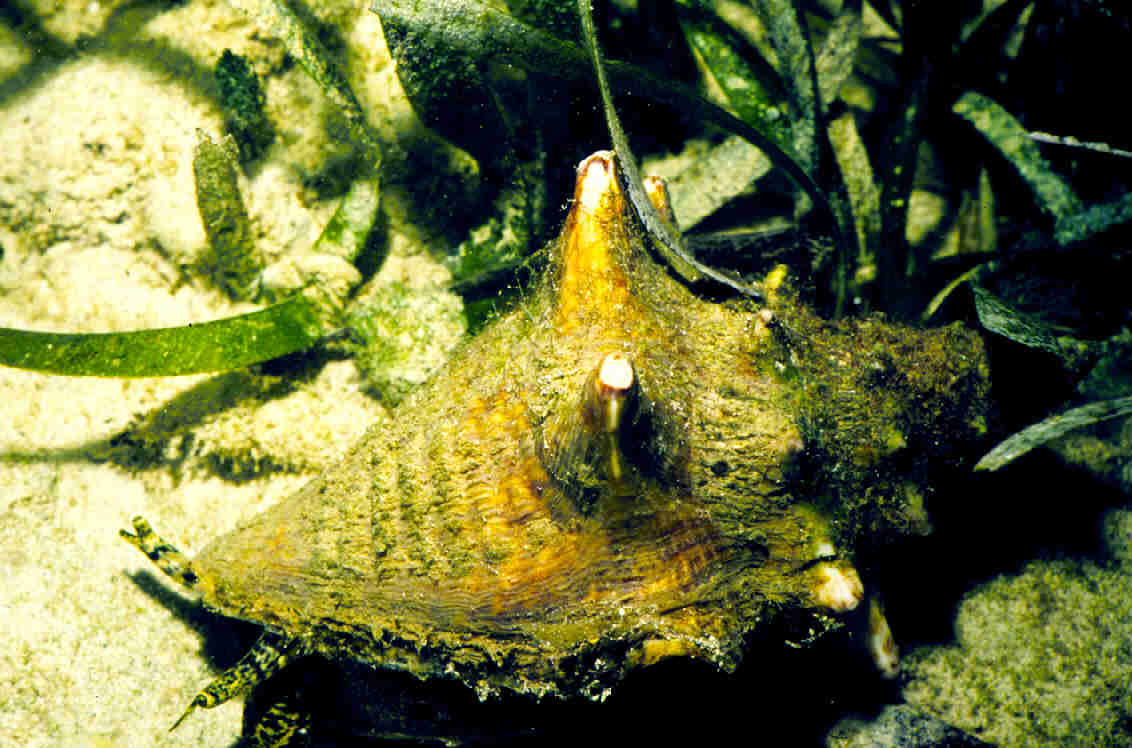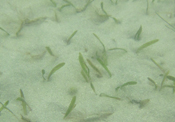Invertebrates and Plants

White Abalone
(Haliotis sorenseni)
Photo: John Butler, NOAA

Queen Conch
(Strombus gigas)
Photo: NOAA

Johnson's seagrass
(Halophila johnsonii)
Photo: Lori Morris, St. Johns River Water Management District

Elkhorn Coral
(Acropora palmata)
Photo: NOAA's Florida Keys National Marine Sanctuary
Mollusks, corals, and brachiopods are three groups of marine invertebrates. For more information about mollusks, marine plants, corals, or brachiopods, please click on the species links below.
Invertebrates
Abalone
Coral
- boulder star coral
- elkhorn coral
- Hawaiian reef coral
- ivory tree coral
- lobed star coral
- mountainous star coral\
- pillar coral
- rough cactus coral
- staghorn coral
- Acropora globiceps coral
- Acropora jacquelineae coral
- Acropora lokani coral
- Acropora pharaonis coral
- Acropora retusa coral
- Acropora rudis coral
- Acropora speciosa coral
- Acropora tenella coral
- Acropora spinosa coral
- Cantharellus noumeae coral
- Euphyllia paradivisa coral
- Isopora crateriformis coral
- Montipora australiensis coral
- Pavona diffluens coral
- Porites napopora coral
- Seriatopora aculeata coral
- Siderastrea glynni coral
- Tubastraea floreana coral
Plants
Mollusks
Mollusks (from the Latin word molluscus, meaning "soft") are a phylum of invertebrates with over 50,000 known species.
There are seven classes of mollusks:
- Gastropoda (e.g., abalone and conch)
- Bivalvia (e.g., oysters and clams)
- Cephalopoda (e.g., octopus and squid)
- Aplacophora (worm-like mollusks)
- Monoplacophora (only mollusk with a segmented internal structure)
- Polyplacophora (e.g., chitons)
- Scaphopoda (e.g., tusk shells)
The majority of mollusks (including abalone) are of the Class Gastropoda, whose name translates from Latin as "stomach foot." Mollusks are soft-bodied animals that may have a hard external shell (composed by secreting calcium carbonate), a hard internal shell, or no shell at all. Mollusks are taxonomically related to annelids (segmented worms) and pogonophora (deep-sea tube worms).
Marine Plants
There are several categories of marine plants, including seagrasses, mangroves, and algae. Seagrasses, such as Johnson's seagrass, are true flowering plants that have adapted to life in the marine environment. Most seagrasses reproduce via pollination (similar to many terrestrial plants) and are found in coastal marine areas. Mangroves are also true flowering plants and are found in coastal waters of varying salinities. Algae are not true flowering plants and range in size from microscopic phytoplankton to large seaweed species.
Brachiopods
Brachiopods are bottom-dwelling, filter-feeding invertebrates whose name translates from Latin as "arm feet." Brachiopods are sessile (stationary, attached), and were the first sessile animals to surround their bodies with a solid external shell. They appear similar to clams on the outside, but have a unique anatomy. Most brachiopods attach to substrate using a muscular stalk (or pedicle) and feed using an appendage called a lophophore. The brachiopoda phylum is common in the fossil record, and brachiopods were extremely abundant in the Paleozoic era. Their numbers were greatly reduced during the Permo-Triassic mass extinction approximately 250 million years ago, and today there are approximately 300 living species of brachiopods. Brachiopods are taxonomically related to bryozoans, or lace corals.
There are two main classes of brachiopod: Inarticulata (e.g., inarticulated brachiopod) and Articulata.
Main Factors for Decline
- Abalone: overharvesting, low population density, loss of genetic diversity, disease, poaching, and natural predation
- Queen Conch: unsustainable harvest
- Plants: habitat alteration due to human and natural perturbations, and degradation of water quality due to nutrient enrichment
- Coral: disease outbreaks since 1980; habitat degradation and modification due to sedimentation; increased predation; hurricanes; pollution; alien species; invasive green algae; limited distribution; damage from mechanical fishing gear, anchors, fish pots, divers, and swimmers; and coral bleaching
- Brachiopods: habitat degradation and alteration, overexploitation, pollution and sedimentation, vulnerable life history characteristics, and limited distribution
More Information
- NOAA Coral Health and Monitoring Program
- NOAA Coral Reef Information System
- Coral Reef Habitat Conservation and Restoration
- CITES (Convention on International Trade in Endangered Species)
Updated: January 27, 2015


